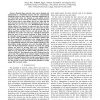159 search results - page 12 / 32 » Codes identifying sets of vertices in random networks |
CORR
2006
Springer
13 years 7 months ago
2006
Springer
One property of networks that has received comparatively little attention is hierarchy, i.e., the property of having vertices that cluster together in groups, which then join to f...
CORR
2010
Springer
13 years 2 months ago
2010
Springer
Random linear network codes can be designed and implemented in a distributed manner, with low computational complexity. However, these codes are classically implemented [1] over fi...
GLOBECOM
2007
IEEE
14 years 1 months ago
2007
IEEE
— In this paper we evaluate outage performance of a cooperative transmission protocol over fading channels that requires a number of relaying nodes to employ a distributed space-...
TCSV
2002
13 years 7 months ago
2002
An important and unsolved problem today is the automatic quantification of the quality of video flows transmitted over packet networks. In particular, the ability to perform this ...
DSN
2005
IEEE
14 years 1 months ago
2005
IEEE
A Cyclic Redundancy Code (CRC), when used properly, can be an effective and relatively inexpensive method to detect data corruption across communication channels. However, some sy...

